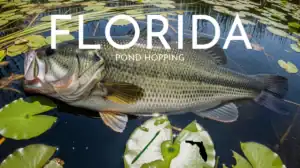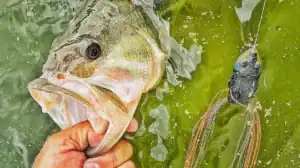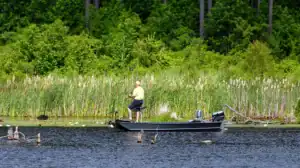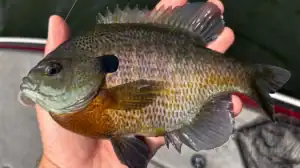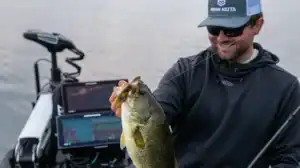As winter gives way to warmer days and water temperatures begin to rise, striped bass (Morone saxatilis) start their annual spring migrations from deep wintering holes to inshore and river systems. For anglers, this is a prime opportunity to connect with some of the hardest-fighting fish in coastal waters, and do so on some pretty light tackle. But early season fishing requires a refined approach — these fish can be finicky, and conditions are often unpredictable. Whether you fish from shore, kayak, or boat, understanding early season striped bass behavior is key to success.
Striped bass share a number of similarities with largemouths, adding to their appeal. Much of the tackle and techniques used to catch them, particularly in the early season, share many similarities with their freshwater relatives.

Before the prevalence of light inshore tackle, most of the gear I used to target them was originally created for green bass. One of my favorite setups involved a spinnerbait rod wearing a Shimano Curado, which was perfect for flinging topwaters such as Zara Spooks and let the stripers show off their fighting abilities. And even today, with all of the excellent lightweight saltwater tackle available, I still use plenty of largemouth tackle.
If you’re a largemouth angler, you owe it to yourself to get after some stripers. And there may be no better time than the spring. Here’s what you need to know to get started.
Choosing the Right Baits

Early in the season, baitfish are often smaller, or even non-existent. In my region, the earliest striped bass arrive before the baitfish do, so they key in on the invertebrates in the area. Blue claw crabs emerge from the mud on the first warm days, and make easy pickings. I don’t use live crabs as bait, though you could probably do well (check local regulations for rules on using crabs and be sure to follow all applicable seasons) with them.
Instead, I’ve found Z-Man’s Kicker CrabZ to work really well when fished deathly slow along the bottom using a jighead just heavy enough to keep it there. Move it along just fast enough to create a puff of mud on the bottom and keep the tail fluttering.
When the baitfish do show up, matching the hatch is the name of the game. Silversides, juvenile herring, mummichogs, and grass shrimp are common prey; all of which are rather small. Selecting lures in the 3- to 5-inch range effectively imitates these smaller baits, and can evoke a strike from even somewhat lethargic stripers. Go with slow and steady retrieves that mimic sluggish early-season bait movement.

Effective Lures Include:
- Small soft plastic swimbaits on light jigheads (Keitech, Zoom, Savage Gear or Z-Man paddletails)
- Unweighted soft plastics like Sluggos or Albie Snax
- Small jerkbaits or suspending plugs (Rapala X-Rap, Yo-Zuri Crystal Minnow)
- Bucktail jigs tipped with curly tails or pork rind
Tackle Selection
While most of the early season stripers will be in the 22- to 32-inch class, there is an opportunity to tangle with some truly outsized bruisers. So you should match your tackle to the size of the fish you’ll likely encounter, with a little extra backbone in case you do battle with a heavyweight. I prefer medium-heavy spinning and baitcasting set ups, which are light enough to provide sport but are capable of wrangling a 40-pound plus fish. If you fish for largemouths, particularly in the thick stuff, you probably already have a rod up to the task.
For smaller baits, I’ve been using G Loomis’ NRX+ inshore spinning rod mated to a Stradic Stradic FM 3000, which has served me well tossing the small soft plastics of the early season. For bigger baits, a Fenwick Elite Inshore gets the nod. I outfitted this with a Penn Slammer, and I’ve used it to land striped bass to 48 inches.

I spool everything with PowerPro or Seaguar Smackdown, opting for a 15 pound test on the smaller set ups and 20 on the heavier gear. Fluorocarbon leaders are all but mandatory in the early season, thanks to the clarity of the water. I select 15-pound test for soft plastics, going up to 30 for topwaters. Seaguar’s Blue Label is my favorite but just about anything in their line up will work.
Recommended Setup:
- 6’ 6”’–7′ medium rod
- 2500–3000 series spinning reel
- 10–15 lb braided line with 15–20 lb fluorocarbon leader
Where To Fish
You can find striped bass in a wide variety of habitats, which only adds to their appeal. But in the early season your best bet is to concentrate on shallow water, such as salt marsh complexes. Some of the best fishing on the Striper Coast takes place in these skinny waters, with action exploding when the bait starts to get flushed out of the creeks.
Marshes act as nurseries for many species of game fish and prey alike. Everything from Atlantic menhaden to weakfish begin their lifecycle amongst the flora that comprise these islands. It is this vegetation that allows these atolls to exist, their roots binding the soil against the corrosive action of wind and tide.
Invertebrates can be found in abundance as well; from the mollusks so familiar at local markets and restaurants to benthic worms that provide an all-you-can-eat buffet for stripers when the moon urges them to hatch in droves. It is this smorgasbord of bite-sized offerings that draws predators out of the relative safety of deeper water.

You should also focus on structure and current breaks. Early season bass often stage near structure that provides ambush points: bridges, jetties, drop-offs, oyster beds, or submerged boulders. These areas hold bait and break up the current, giving stripers an ideal spot to wait and strike.
Boat and kayak anglers should work channel edges, especially where creeks and rivers flow into bays. Shore anglers can target bridge shadow lines or rocky points with moving water.
Tide Phase
Someone once said there’s two good times to go fishing: when it’s raining and when it’s not. This is true to a degree; you can’t catch them on the couch and you have to make the most of your opportunities. But to put up big numbers of stripers you need to play the tides effectively. I have found that under most circumstances, the best time to fish shallows like the salt marsh or tidal rivers is an hour before the peak of high, staying until you run out of water.
The exception to this rule is a moon tide, when the water rises far enough above the grass that the stripers are no longer confined by the channel edges and can fan on top of usually dry grass in pursuit of baitfish. This is not to say you won’t pick up a fish here and there, you just won’t connect like you will when the high marsh starts to drain, concentrating food sources in the deeper channels as the creeks empty.

Temperature
I have found the magic number to be 64 degrees. The fishing has broken wide open when the water temperature hits that number, according to my logs. It seems to be just warm enough to stimulate their metabolism, but not warm enough to make them sluggish.
The action seems to be white hot until the temperature hits 70 degrees or so, although you can continue to catch fish in the back when periods of high tide coincide with dawn and dusk. There’s usually a few days a month that can be productive even in the warmest months.
You want to take advantage of the tail of the flood tide in the height of summer; those ocean currents bring in cooler water with gamefish floating in along with them.
Position of the Sun

The noonday sun is almost sure to chase predatory fish to the sanctuary of deep water in the warmer months. But the sun’s rays can be an advantage in the early season, changing water temperatures by as much as 10 degrees, turning striped bass on and getting them to feed.
Dark mud bottoms, like those found in the salt marsh, heat up faster than the surrounding earth, which can make them the first hotbed of activity in the early season. Key in on these, especially later in the day when they have had a chance to warm up.
Stay Mobile and Cover Water
Until the main biomass arrives, early season fishing can be hit or miss. If you’re not seeing bait or marking fish after 30–45 minutes, move. Use your electronics to find water temp changes, bait balls, or marks along channel edges. Also look for signs of bait and bass, such as surface disruptions caused by fleeing bait or the wake of a cruising striper.
Shore-bound or wading anglers should cover ground by walking and casting. If there is nothing visible to cast to, like structure in the form of exposed rocks or pilings, blind cast in a fan pattern around you as you move. Of course, if you get a hit or follow, concentrate on that spot.
Put the Sneak On

Most salt marshes or other estuaries are shallow; averaging four to six feet on all but the steepest of tides. As such, stealth is the key. Even the simple act of dropping something on deck can be enough to put the fish down for hours. Your approach should be as cautious as possible, coming off plane well before the area you plan to fish.
If possible, turn your motor off without shifting out of gear and drift into place, as the clunking of your boat’s transmission is a proven way to scare fish. If you have a trolling motor or push pole, this is definitely the time to use it. Likewise, wading anglers will also benefit from a healthy dose of creep.
Final Thoughts
Early season striper fishing is all about patience, observation, and subtlety. While the fish may not be as aggressive or numerous as in the fall, the rewards are still there — often in the form of less-crowded waters, a chance at the first fish of the season, and the satisfaction of working for your bites.
By paying close attention to water temperature, downsizing your presentations, and fishing smart around structure and tides, you can stack the odds in your favor and enjoy some exciting early spring action.
Tight lines and happy hunting—those spring bass are waiting. Especially for those sweetwater bass anglers looking for their first taste of the salt.




